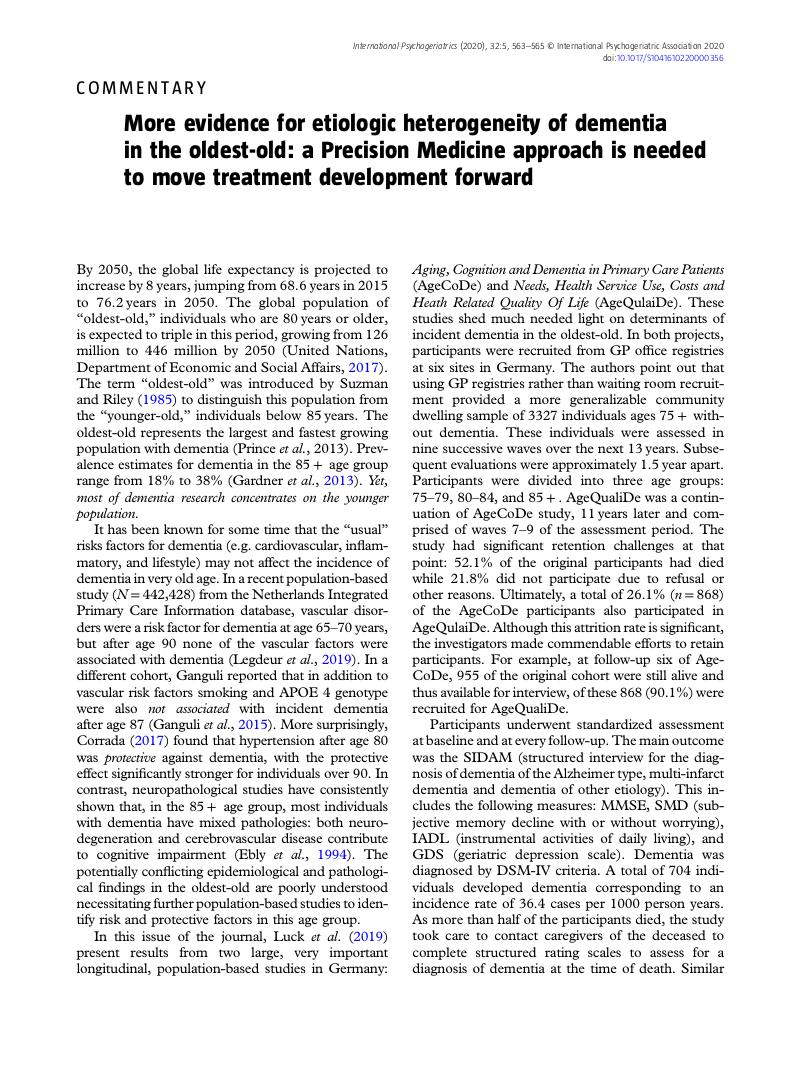No CrossRef data available.
Article contents
More evidence for etiologic heterogeneity of dementia in the oldest-old: a Precision Medicine approach is needed to move treatment development forward
Published online by Cambridge University Press: 06 May 2020
Abstract
An abstract is not available for this content so a preview has been provided. Please use the Get access link above for information on how to access this content.

- Type
- Commentary
- Information
- International Psychogeriatrics , Volume 32 , Issue 5: Issue Theme: Challenges and Facilitators for Diagnosis and Treatment of Dementia , May 2020 , pp. 563 - 565
- Copyright
- © International Psychogeriatric Association 2020
References
Beam, C. R., Kaneshiro, C., Jang, J. Y., Reynolds, C. A., Pedersen, N. L. and Gatz, M. (2018). Differences between women and men in incidence rates of dementia and Alzheimer’s disease. Journal of Alzheimer’s Disease: JAD, 64(4), 1077–1083. doi: 10.3233/JAD-180141CrossRefGoogle ScholarPubMed
Corrada, M. M., Brookmeyer, R., Berlau, D., Paganini-Hill, A. and Kawas, C. H. (2008). Prevalence of dementia after age 90: results from the 90+ study. Neurology, 71, 337–343. doi: 10.1212/01.wnl.0000310773.65918.cdCrossRefGoogle ScholarPubMed
Corrada, M. M.et al. (2017). Age of onset of hypertension and risk of dementia in the oldest-old: the 90+ Study. Alzheimer’s & Dementia, 13, 103–110.10.1016/j.jalz.2016.09.007CrossRefGoogle Scholar
Ebly, E. M., Parhad, I. M., Hogan, D. B. and Fung, T. S. (1994). Prevalence and types of dementia in the very old: results from the Canadian study of health and aging. Neurology, 44, 1593–1600. doi: 10.1212/WNL.44.9.1593CrossRefGoogle ScholarPubMed
Ganguli, M., Lee, C. W., Snitz, B. E., Hughes, T. F., McDade, E. and Chang, C. C. (2015). Rates and risk factors for progression to incident dementia vary by age in a population cohort. Neurology, 84, 72–80.10.1212/WNL.0000000000001113CrossRefGoogle Scholar
Gardner, R. C., Valcour, V. and Yaffe, K. (2013). Dementia in the oldest old: a multi-factorial and growing public health issue. Alzheimer’s Research & Therapy, 5(4), 27. doi: 10.1186/alzrt181CrossRefGoogle ScholarPubMed
Heeren, T. J., Lagaay, A. M., Hijmans, W. and Rooymans, H. G. (1991). Prevalence of dementia in the ‘oldest old’ of a Dutch community. Journal of the American Geriatrics Society, 39, 755–759.10.1111/j.1532-5415.1991.tb02696.xCrossRefGoogle ScholarPubMed
Legdeur, N., et al. (2019). The association of vascular disorders with incident dementia in different age groups. Alzheimer’s Research & Therapy, 11(1), 47. doi: 10.1186/s13195-019-0496-xCrossRefGoogle ScholarPubMed
Lourida, I.et al. (2019). Association of lifestyle and genetic rish with incidence of dementia. JAMA, 322, 430–437. doi: 10.1001/jama.2019.9879CrossRefGoogle Scholar
Lyketsos, C. G., Steinberg, M., Tschanz, J. T., Norton, M. C., Steffens, D. C. and Breitner, J. C. (2000). Mental and behavioral disturbances in dementia: findings from the Cache County study on memory in aging. The American Journal of Psychiatry, 157,
708–714.10.1176/appi.ajp.157.5.708CrossRefGoogle Scholar
Lyketsos, C. G.et al., (2011). Neuropsychiatric symptoms in Alzheimer’s disease. Alzheimer’s & Dementia: The Journal of the Alzheimer’s Association, 7(5), 532–539. doi: 10.1016/j.jalz.2011.05.2410CrossRefGoogle ScholarPubMed
Luck, T., Pabst, A., Roehr, S., Wiese, B., Eisele, M., Heser, K., et al. (2019) Determinants of incident dementia in different old age groups: Results of the prospective AgeCoDe/AgeQualiDe study. International Pyschogeriatrics, 32, 645–659.CrossRefGoogle Scholar
Muszyńska, M. M. and Rau, R. (2012). The old-age healthy dependency ratio in Europe. Journal of Population Ageing, 5(3), 151–162. doi: 10.1007/s12062-012-9068-6CrossRefGoogle ScholarPubMed
Prince, M., et al. (2013). The global prevalence of dementia: A systematic review and metaanalysis. Alzheimer’s & Dementia, 9, 63–75, e62. doi: 10.1016/j.jalz.2012.11.007CrossRefGoogle Scholar
Rastas, S., et al. (2006). Association between blood pressure and survival over 9 years in a general population aged 85 and older. Journal of the American Geriatrics Society, 54, 912–918. doi: 10.1111/j.1532-5415.2006.00742.xCrossRefGoogle Scholar
Suzman, R. and Riley, M. W. (1985). Introducing the ‘oldest old’. The Milbank Memorial Fund Quarterly Health and Society, 63, 177–186.10.2307/3349879CrossRefGoogle Scholar
Tschanz, J. T., Treiber, K., Norton, M. C., Welsh-Bohmer, K. A., Toone, L., Zandi, P. P., et al. (2005). A population study of Alzheimer’s disease: findings from the Cache County Study on memory, health, and aging. Care Management Journal, 6, 107–114. doi: 10.1891/cmaj.6.2.107CrossRefGoogle Scholar
United Nations , Department of Economic and Social Affairs (2017). World Population Prospects: The 2017 Revision, Key Findings and Advance Tables. Working Paper No. ESA/P/WP/248.Google Scholar
U.S. National Library of Medicine (2018). What is the Precision Medicine Initiative? Available online: https://ghr.nlm.nih.gov/primer/precisionmedicine/initiativeGoogle Scholar
Yaffe, K., et al. (2011). Mild cognitive impairment, dementia, and their subtypes in oldest old women.
Archives of Neurology, 68, 631–636. doi: 10.1001/archneurol.2011.82CrossRefGoogle ScholarPubMed




